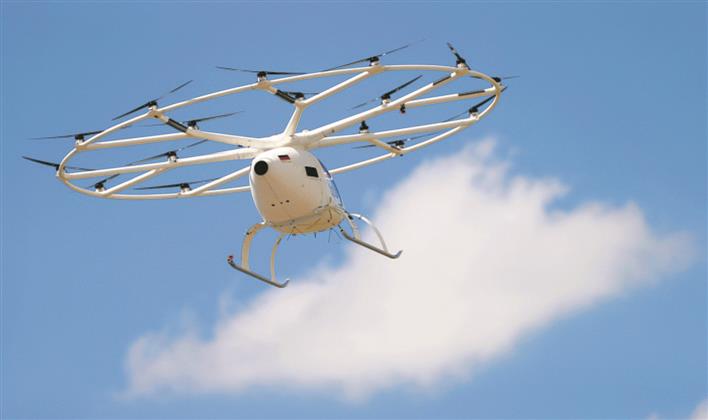In December 2019, heavy-lifting drones were used by Pakistan to drop AK-47 rifles, counterfeit currency and narcotics in Punjab’s border districts. But the Jammu drone attack is something new. Contemporary drones cost little, and availability is aplenty. Drones represent an asymmetric threat that can cause serious damage and create panic.

Wise Course: It is better to bring down a drone intact for forensic analysis and intelligence-gathering than destroy it. Reuters

In the age of the Almighty Computer, drones are the perfect warriors. They kill without remorse, obey without kidding around, and they never reveal the names of their masters.
Eduardo Galeano, Uruguayan writer
IN August 2017, aircraft carrier Queen Elizabeth of the UK Royal Navy was docked at Invergordon when an amateur photographer flew a drone close to the giant battleship. When the drone sensed a high wind risk, it landed itself on the ship. The pilot (with the remote) told BBC that he could easily have carried two kilograms of high explosives and left it on the deck.
An assassination attempt was made on Venezuela President Nicolas Maduro on August 4, 2018, with a drone. Two drones loaded with one kilogram of explosives each were flown close to the president while he was addressing a military parade. They were detected by the alert security personnel. One drone was electronically diverted from its course and the second crashed against a wall.
December 20, 2018, saw drones dramatically disrupt air travel after someone brought London’s Gatwick airport to a complete halt by flying drones intermittently over the airport’s lone runway. Air traffic at other London airports, including Heathrow, was also disrupted momentarily over fears of a coordinated drone assault against all five of London’s commercial airports.
In December 2019, heavy-lifting drones were used by Pakistan to drop AK-47 rifles, counterfeit currency and narcotics in 10 sorties spanned over eight days in Punjab’s border districts More such incidents have been reported. Sunday’s drone attack on the Jammu Air Force base is new and extremely belligerent. This aggressiveness needs to be nipped in the bud to prevent further escalation. Clearly, the threat from the drones is a cause for serious concern. Contemporary drones cost little, and availability is aplenty. Drones today represent an asymmetric threat that can cause serious damage and create panic.
Drones being small, silent and discreet are difficult to detect and bring down. They can be pre-programmed and/or remote controlled even with smart phones. Rapid miniaturisation of electronics and batteries are a boon to the growth of drones. Additional features like auto landing, dynamic homing and orientation control provide greater stability and effective control. High-end cameras with axis stabilisation provide a smooth and stable recording experience with high-quality videos. They are symmetric in shape and can fly in any direction. They can be armed with weapons, explosives and/or cameras. They can also carry hacking-capable devices, such as small on-board computers (e.g., a Raspberry Pi), Wi-Fi/Bluetooth dongles (to monitor and detect vulnerabilities in networks) and trigger an attack on the computer/network.
Big investments in countermeasures are inescapable. Any control measure would necessarily be working under extreme capability of precision and real-time response. To observe, detect and analyse a rogue drone would require tracking its flight path precisely. An effective sensor system will monitor electronic radio data and the designated airspace with video cameras (quite like the CCTVs watching over a crowded marketplace). These devices would trigger alarms automatically on spotting and initiate the analysis process, identify control commands being transmitted to the drones by radio and register the drone type and characteristics to classify the threat.
Once a hostile drone is identified, measures to bring it down commence. These may be the use of guns and explosives to destroy it or electronically jam it and force it to land. It is very desirable that the actions of detection, identification and destruction/disablement take place automatically. This would require all the participating defensive elements to be electronically integrated. The electronics used must not pose a threat to other friendly flying objects in the vicinity and cause collateral damage to infrastructure. The countermeasures will also have to be layered and gridded to provide an effective defence shield; any single point of failure is simply unacceptable.
It is preferable that instead of destruction, the drone is brought down intact to allow forensic analysis and intelligence-gathering to eliminate threats and prevent future attacks. Some well-established physical countermeasure are: well-trained snipers to shoot them down with pellet guns, man-portable launchers to launch nets to physically capture drones and bring them down with a parachute. Electronic countermeasures take over remote control signals and the Global Positioning System (GPS) signals to disorient and capture the drone. Lasers are becoming a feasible option. However, directed energy weapons are still experimental from an operational standpoint.
The detection and identification systems include contemporary technology devices like modular and fully configurable 3D radar sensor, MIMO (multiple-input multiple-output) radars to improve detection accuracy, radio frequency sensors and acoustic sensors. The electronic countermeasures include a fully integrated and automated directional or omnidirectional jammer for neutralisation of drones and a dedicated web application for controlling the system.
As the concern surrounding drone safety continues to grow, fresh and innovative technologies will continue to evolve, and the trick lies in keeping pace. The time to prevent any future belligerence is now.
